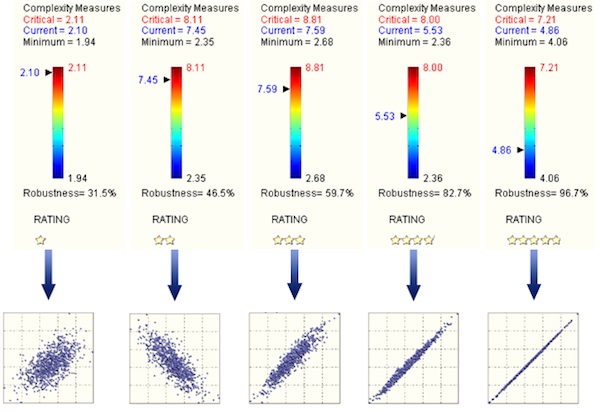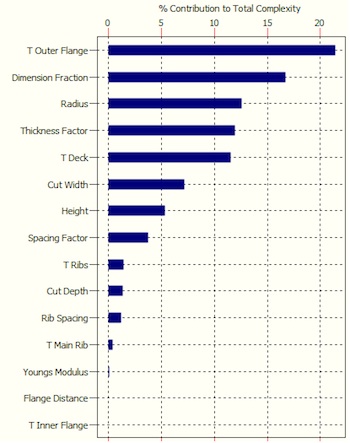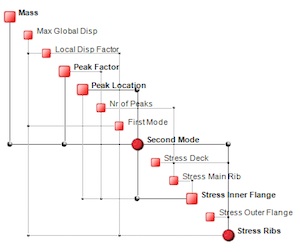Ontonix Launches Design for Resilience Engineering Portal
Web-based service allows engineers to measure complexity of systems.
Latest News
November 8, 2011
By DE Editors
Ontonix (Como, Italy), the developer of the OntoSpace system for measuring and managing complexity, has launched the Design for Resilience (D4R) engineering portal with the intent of helping companies address the risks of excessive complexity in their systems and designs. Excessive complexity, says the company, is the primary source of fragility and failure in sophisticated engineering products and systems. Using D4R to measure the complexity of a given design or product, says Ontonix, makes it possible to apply complexity as a design attribute and mitigate its risks from the earliest stages of development.
“Even though robustness and robust design is the goal of engineers and designers, there ]have been] no tools that would actually allow you to measure robustness,” said Dr. J. Marczyk, founder and chief technical officer of Ontonix, in a press statement. “With our complexity-based approach, we are able to bridge this gap.”

Figure 1: Examples of the 1 through 5-star systems and typical scatter plots produced by D4R.
A Web-based service, D4R is powered by Ontonix’s OntoNet, which is described as a complexity computation engine. The service’s tools are said to enable engineers to measure the robustness and complexity of systems and thus provide engineers the ability diagnose and expose fragilities hidden in their systems or designs. Additionally, the service provides a rating system that allows engineers to rank system variables in terms of how given variables impact functionality and resilience.
Design variables, says the company, drive complexity and ultimately robustness. D4R extends the data you’ve already produced with, say, a Monte Carlo simulation, design of experiments, parametric/sensitivity studies, or time-domain simulations. It computes your system’s robustness and complexity using sampled values of your design variables and system outputs, such as dimensions, material properties, boundary conditions, stresses, acceleration, and frequencies.
 Figure 2: Example of a D4R Complexity Profile of a mechanical system. |
D4R analyzes your data and produces a so-called Complexity Profile. The D4R Complexity Profile provides a breakdown of your system’s total complexity. This profile shows how design variables such as tolerances or imperfections affect complexity, which indicates that these variables must be reduced to increase system robustness. Results are displayed graphically and are accompanied by scaled rankings that facilitate interpretation of results.
To use D4R, you need a rectangular array in which the columns represent your system variables while the rows represent sample values, says the company. The process to obtain a report on your design’s or system’s robustness is as follows:
- You upload an Excel spreadsheet with your data to D4R
- D4R analyzes the data in one minute, according to the company
- You download a two-page report in PDF format
Pricing for D4R is based on credits and array sizes. A report with up to a 50x50 array costs one credit. A report with up to a 50x100 array is four credits, according to the website. Credits are listed as costing €1 each and are available in sliding scale bundles ranging from 10 to 1,000 credits. In addition to the two-page report, you can purchase a System Map that represents your design or system.
The System Map, which is built based on your raw data, visually indicates which variables are related and which are important. The System Map is intended to be explored interactively with a no-cost app available from the company called MAPVIEW. System Map pricing is marginally higher than the report’s pricing.
 Figure 3: This D4R image depicts a System Map synthesized by processing Monte Carlo Simulation results obtained with a commercial finite element solver. |
D4R is powered by Ontonix’s OntoNet, which is described as a complexity computation engine. OntoNet can be licensed as a stand-alone module and integrated into any simulation data management system or software tool. Ontonix also offers an on-line service that enables users to perform near real-time self-rating of their business resiliency.
“Highly complex products and processes are inherently fragile,” said Marczyk. “It is imperative that both complexity and robustness become design attributes just like stresses, stiffness, or fatigue life to engineer safer and more efficient solutions. Being able to incorporate complexity at the heart of the design loop opens new exciting possibilities such as complexity-based CAD.”
For more information on the Ontonix Design for Resilience engineering portal, click here.
Download a white paper further explaining D4R.
Upload a data array to D4R and try it free. (Note: Two columns and 3 rows of numerical data minimum.)
Learn about Ontonix’s business resiliency portal.
Go here for more on OntoSpace complexity measurement and management system.
See why DE‘s editors selected the Design for Resilience engineering portal as their Pick of the Week.
Sources: Press materials received from the company and additional information gleaned from the company’s website.
Subscribe to our FREE magazine, FREE email newsletters or both!
Latest News
About the Author
DE’s editors contribute news and new product announcements to Digital Engineering.
Press releases may be sent to them via [email protected].






